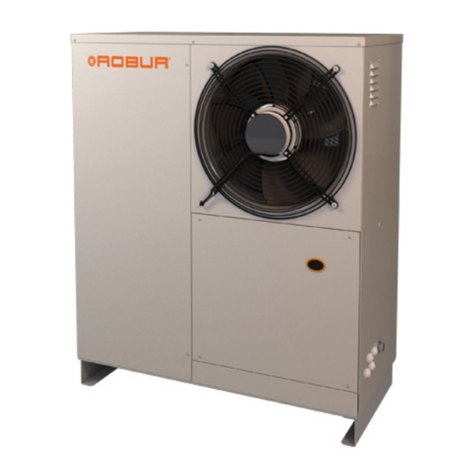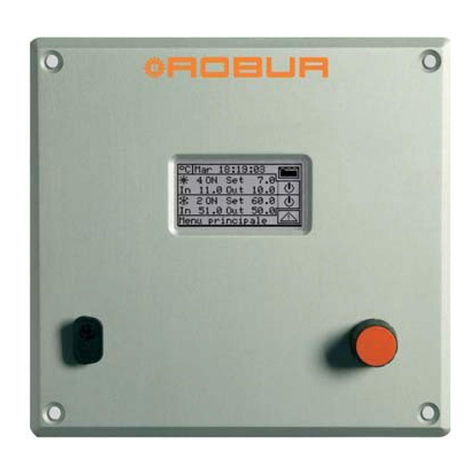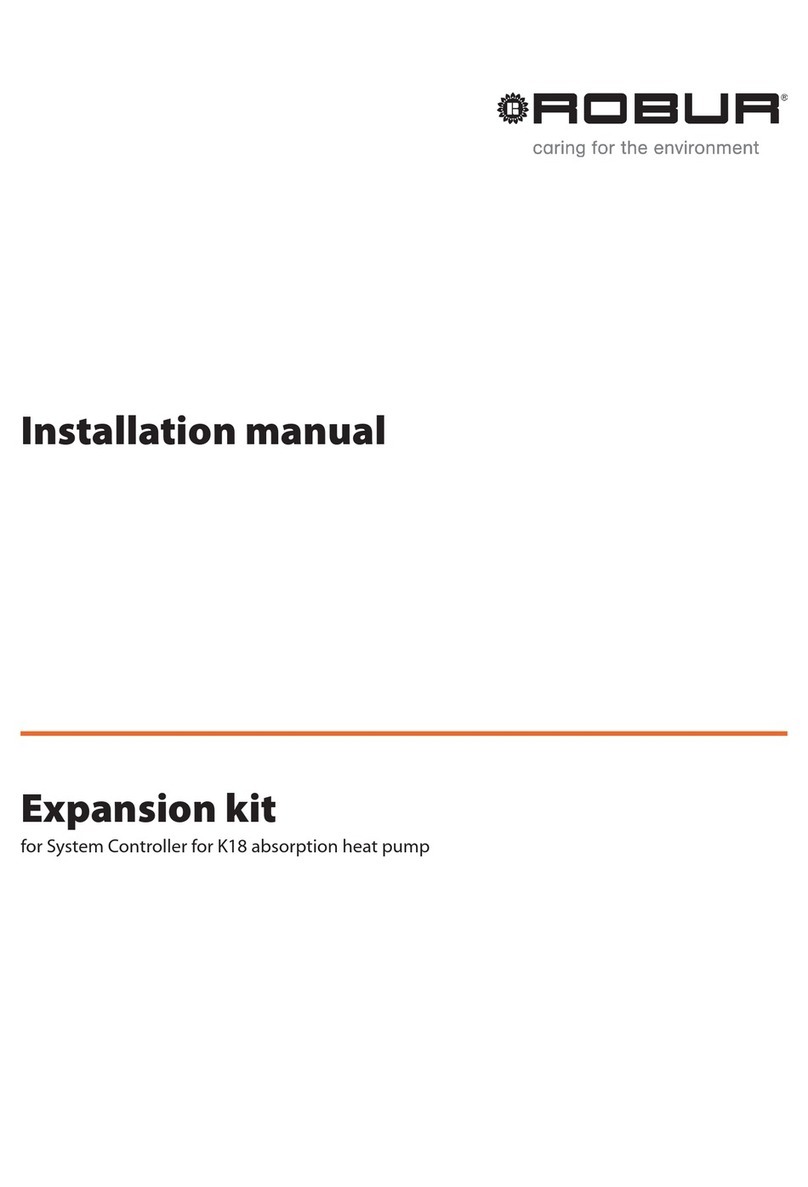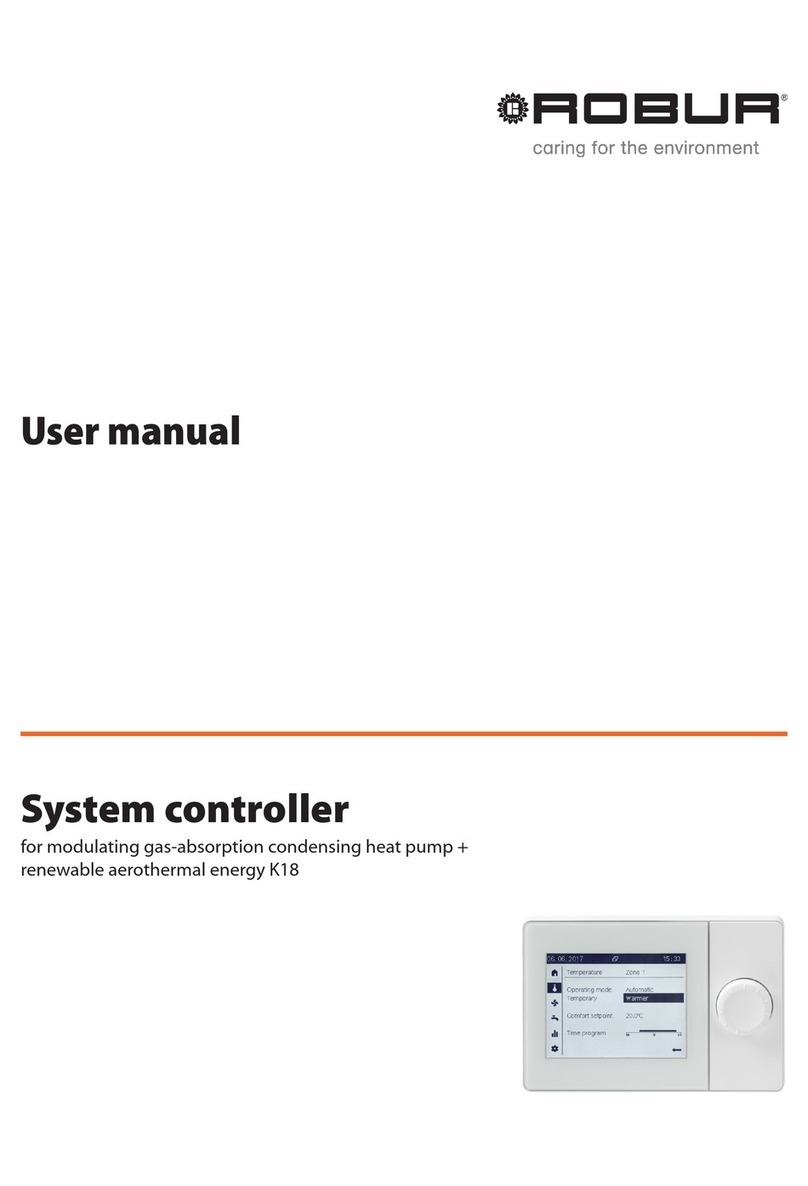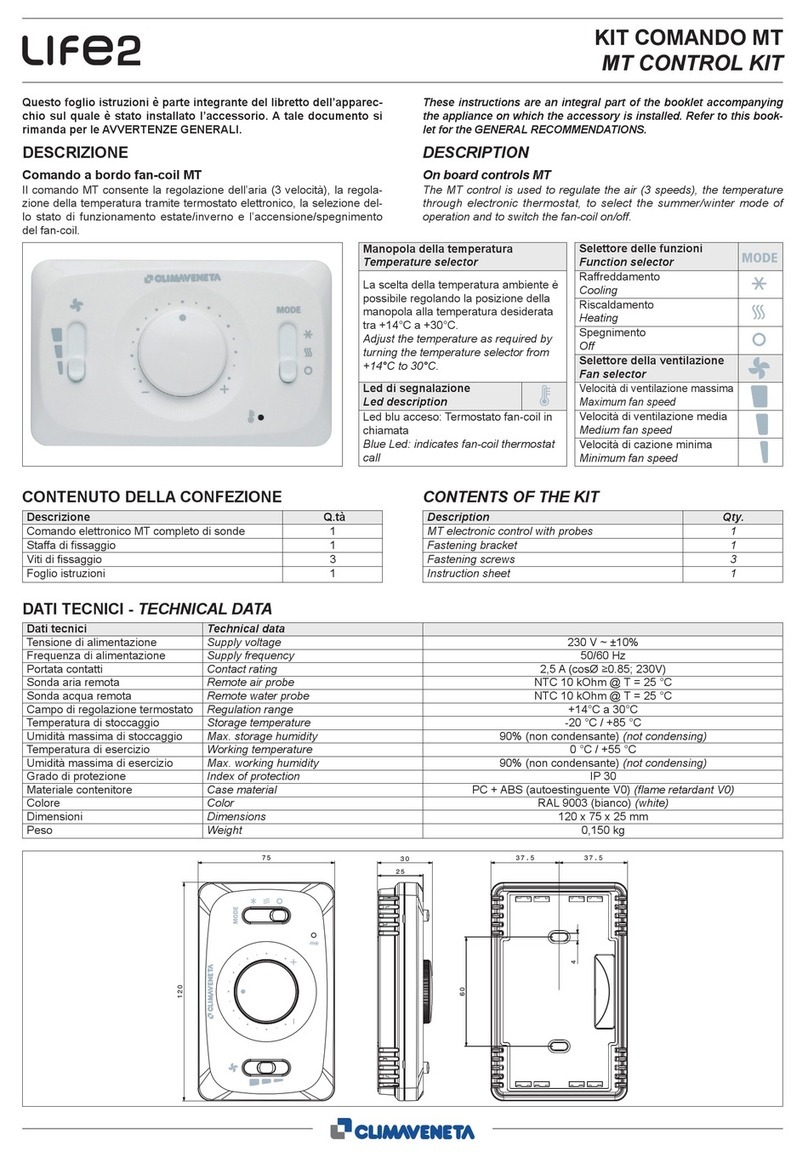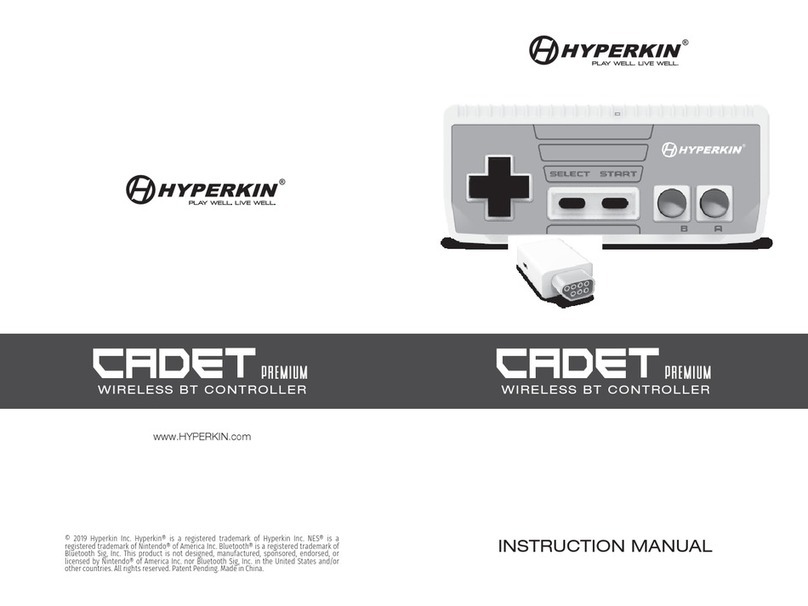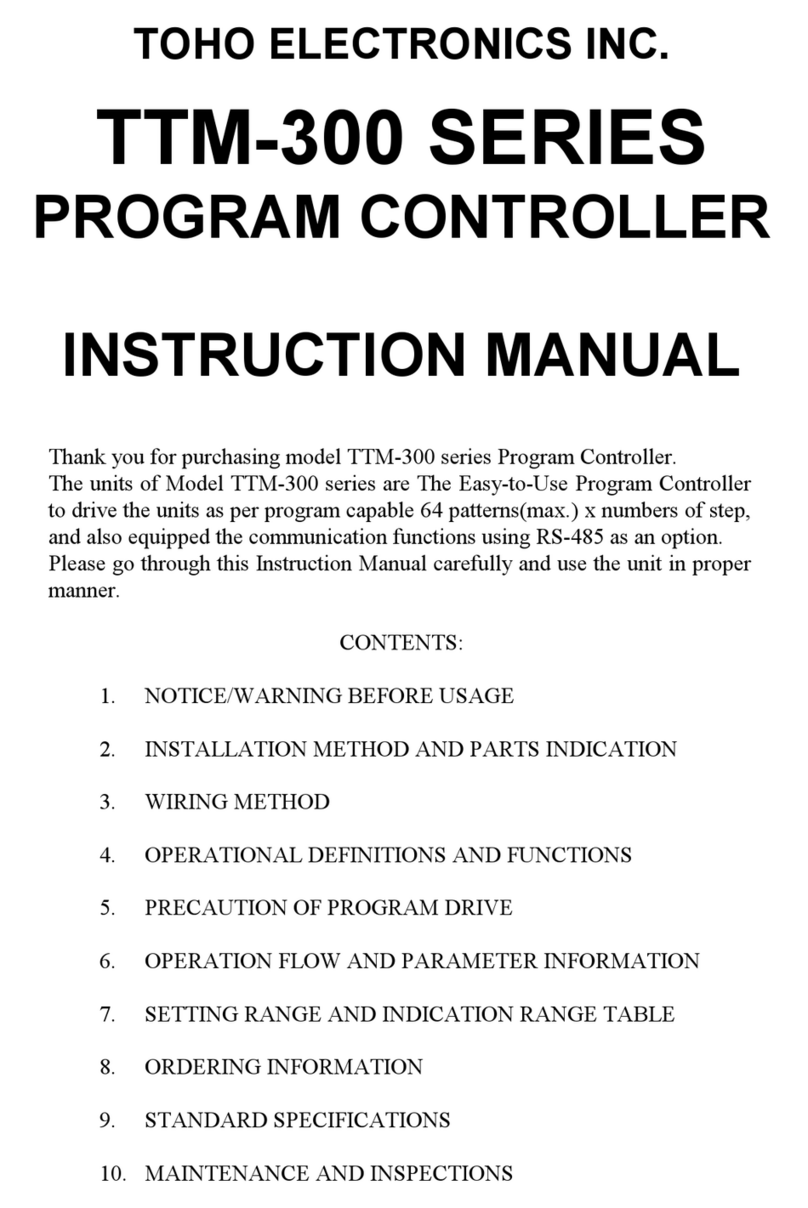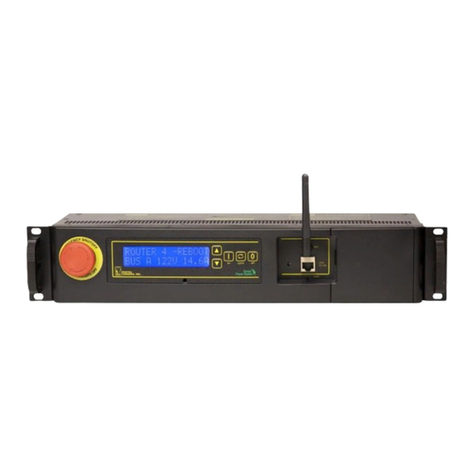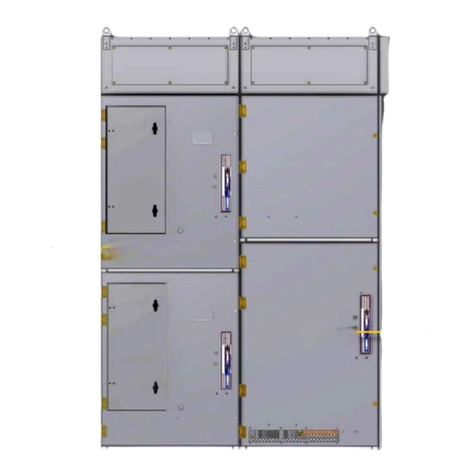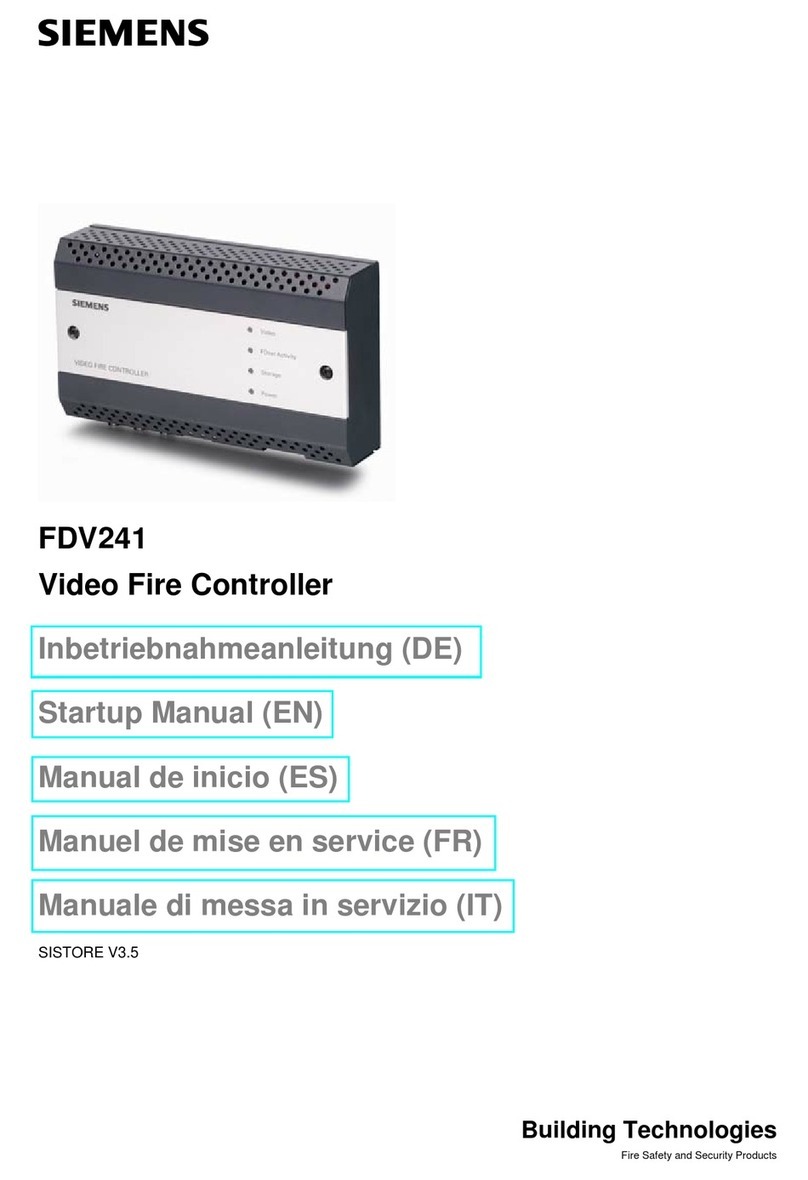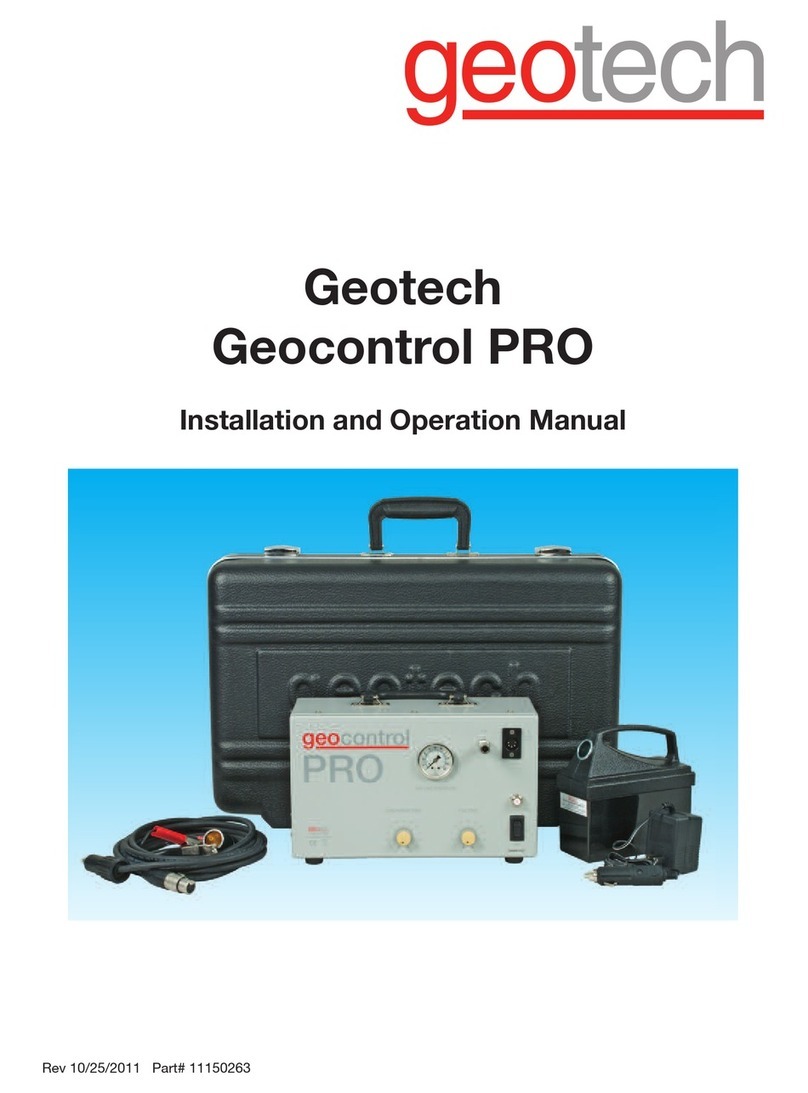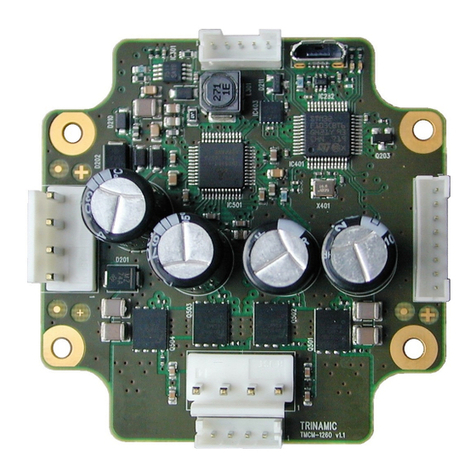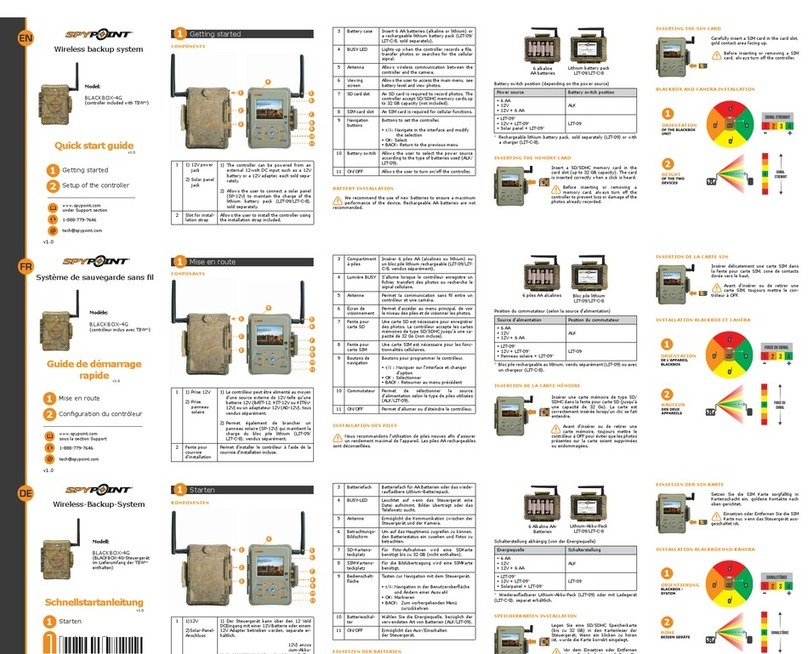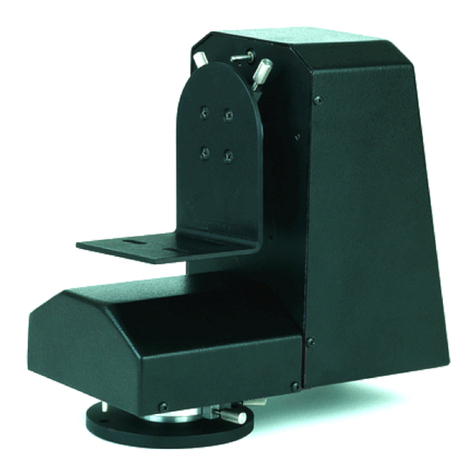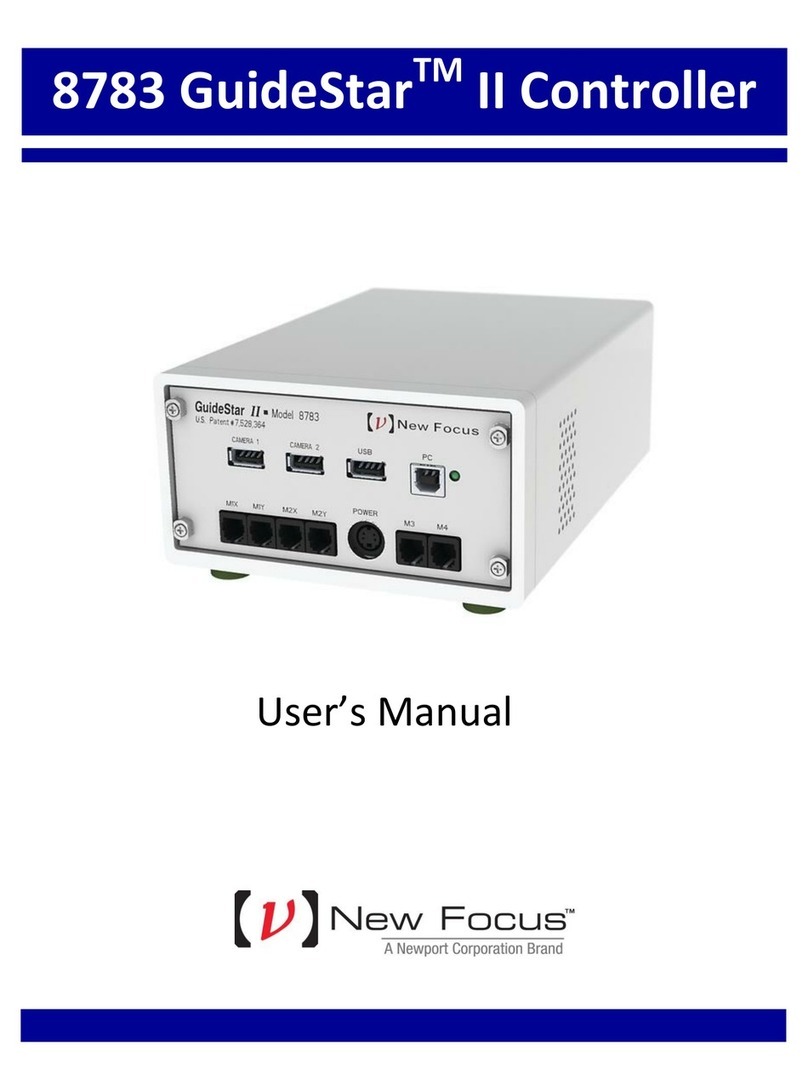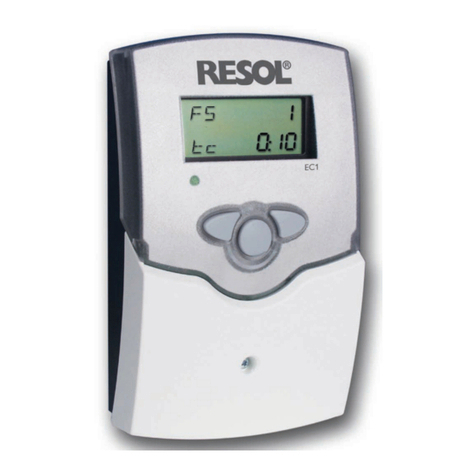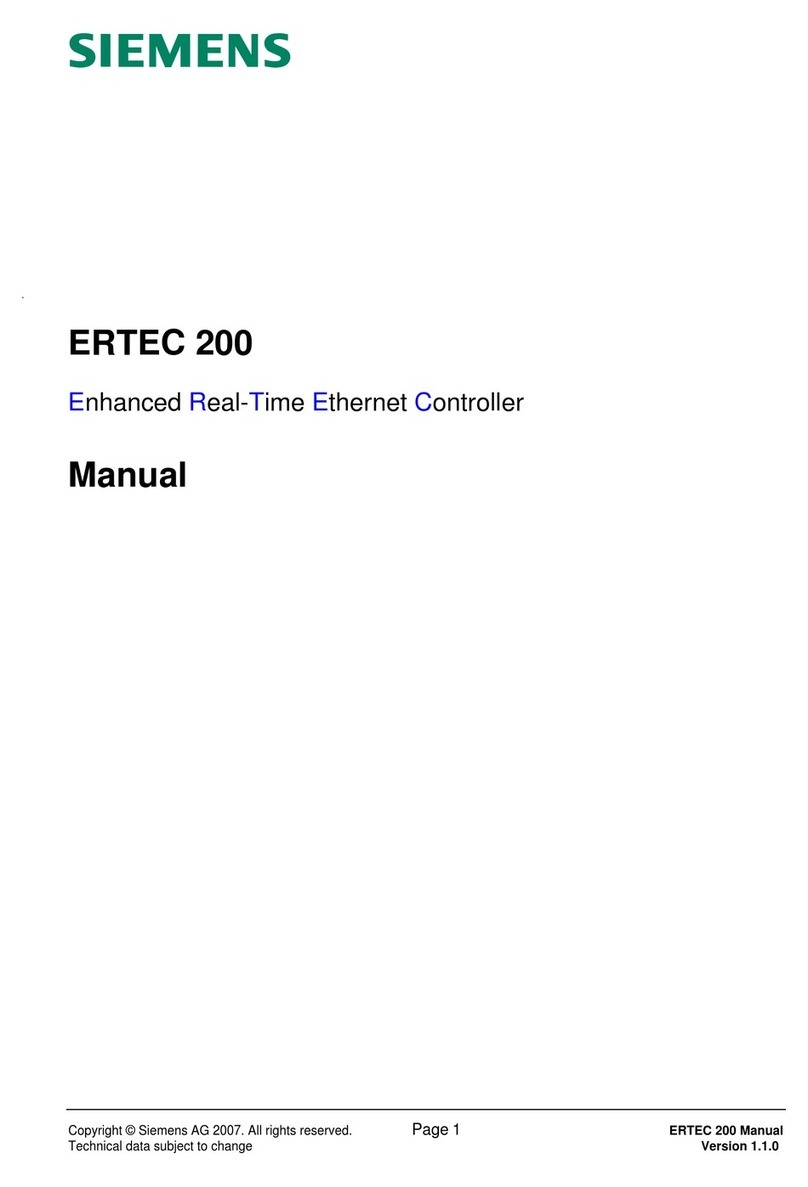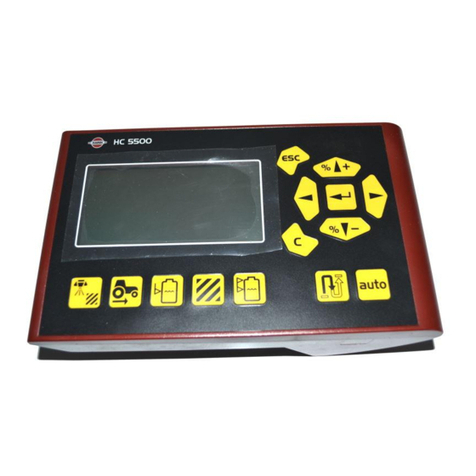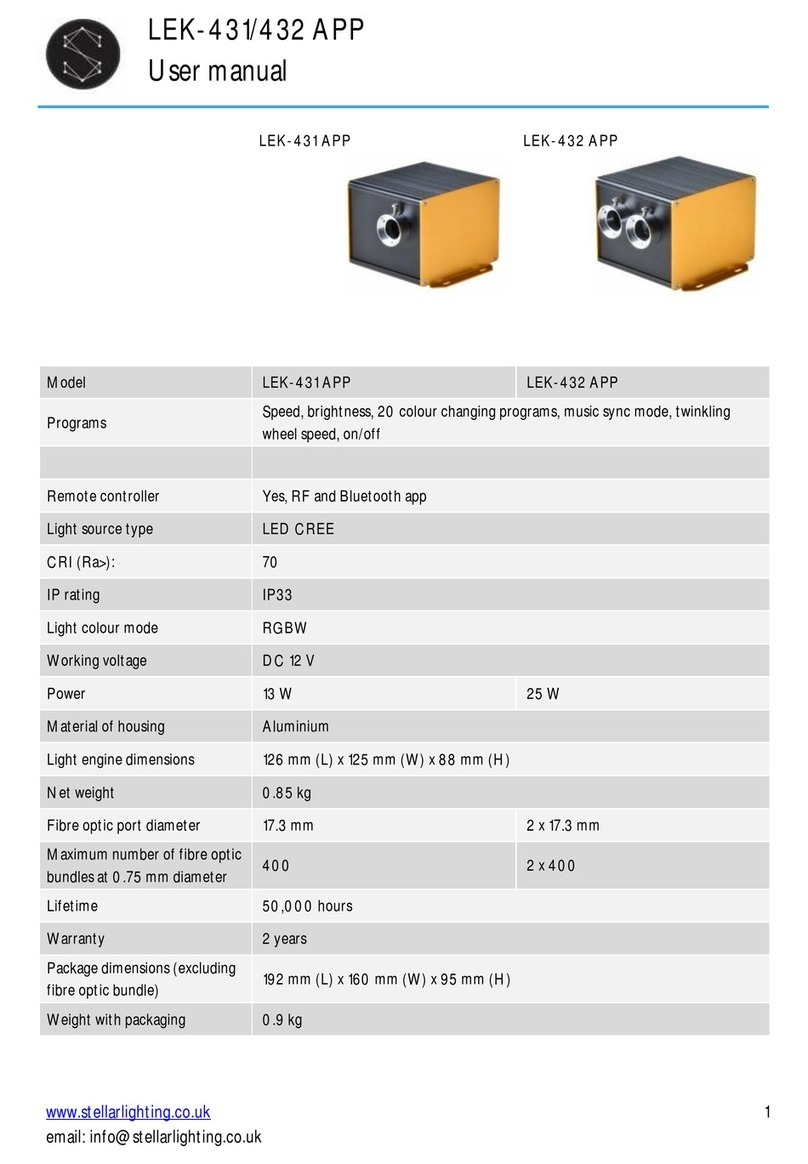Robur Cascade controller Guide

for the centralized control of Caldaria systems and their
distribution circuits
Cascade controller
Installation and use manual

This Installation and use manual has been drawn up and printed by Robur S.p.A.; whole or partial reproduction of
this Installation and use manual is prohibited.
The original is led at Robur S.p.A.
Any use of this Installation and use manual other than for personal consultation must be previously authorised by
Robur S.p.A.
The rights of those who have legitimately led the registered trademarks contained within this publication are not
aected.
With the aim of continuously improving the quality of its products, Robur S.p.A. reserves the right to modify the
data and contents of this Installation and use manual without prior notice.
Revision: D
Code: D-LBR874EN
DISPOSAL
The appliance and all its accessories must be disposed of separately in accordance with the regulations in force.
Use of theWEEE symbol (Waste Electrical and Electronic Equipment) indicates that this product cannot be disposed of as house-
hold waste. Proper disposal of this product helps to prevent potential negative consequences for the environment and human
health.

Installation and use manual – Cascade controller ODSP039 3
INDEX OF CONTENTS
I Introduction..........................................................................
p.4
I.1 Recipients................................................................
p.4
I.2 Available languages ............................................
p.4
II Symbols and denitions.........................................
p.4
II.1 Key to symbols ......................................................
p.4
II.2 Terms and denitions .........................................
p.4
III Warnings ...................................................................................
p.4
III.1 General and safety warnings............................
p.4
III.2 Compliance.............................................................
p.5
III.3 Exclusions of liability and warranty ...............
p.5
1 General information....................................................
p.6
2 Technical data .....................................................................
p.6
3 Mounting and installation....................................
p.7
3.1 Mounting and connecting the OT/Modbus
interface...................................................................
p.7
3.2 Electrical hookup..................................................
p.9
4 Preliminary operations for
programming.....................................................................
p.11
5 Control panel......................................................................
p.12
6 Menus and parameters...........................................
p.13
6.1 Access to menus and parameters.................
p.13
6.2 Basic parameter programming .....................
p.13
6.3 Complete parameter programming............
p.15
7 System examples...........................................................
p.30
7.1 1 boiler, DHW with diverter valve, 3 circuits
of which 2 mixed................................................
p.30
7.2 1 boiler, DHW with delivery, 3 circuits of
which 2 mixed .....................................................
p.31
7.3 1 boiler, DHW with diverter valve, heat
exchanger, 2 circuits of which 1 mixed.......
p.32
7.4 1 boiler, DHW with delivery, heat
exchanger, 3 circuits of which 1 mixed.......
p.33
7.5 3 boilers, DHW with diverter valve, 2
circuits of which 1 mixed.................................
p.34
7.6 3 boilers, DHW with delivery, 3 circuits of
which 1 mixed .....................................................
p.35
7.7 3 boilers, DHW with diverter valve, heat
exchanger, 2 circuits of which 1 mixed.......
p.36
7.8 3 boilers, DHW with delivery, heat
exchanger, 3 circuits of which 2 mixed.......
p.37
7.9 2 boilers, DHW with delivery, heat
exchanger, 3 circuits of which 1 mixed.......
p.38
7.10 3 boilers, DHW with 2 diverter valves, 2
circuits of which 1 mixed.................................
p.39
7.11 3 boilers, DHW with 2 deliveries, 4 circuits
of which 1 mixed................................................
p.40
7.12 3 boilers, DHW with diverter valve and
delivery, 3 circuits of which 1 mixed............
p.41
7.13 3 boilers, heating only, 0-10 V external
input, 2 circuits of which 1 mixed.................
p.42
8 Fault codes............................................................................
p.43
9 Menus and parameters table...........................
p.44

Introduction
4
I
I INTRODUCTION
Installation and use manual
This Installation and use manual contains all the
information needed to install and congure the
Cascade controller ODSP039, which can only be
used in conjunction with one or more Caldaria
systems, each of which must be equipped with
its own OT/Modbus interface (optional ODSP040),
with the exception of Caldaria 100.2 units that are
already equipped with it.
The controller is a programmable digital controller,
suitable for DIN rail mounting and capable of per-
forming sophisticated temperature control func-
tions. The large display allows easy entry of system
parameters.
I.1 RECIPIENTS
This Manual is intended for:
▶
Electrical installers for proper installation of the con-
trol equipment.
▶
Installers and authorised Robur Technical Assistance
Centres (TAC) for conguration.
I.2 AVAILABLE LANGUAGES
For versions of this Installation and use manual in other
languages, see Robur website.
II SYMBOLS AND DEFINITIONS
II.1 KEY TO SYMBOLS
DANGER
WARNING
NOTE
PROCEDURE
REFERENCE (to other document)
II.2 TERMS AND DEFINITIONS
Boiler = condensing boiler series Caldaria.
controller = control unit for cascade and any second-
ary circuits management for condensing boilers series
Caldaria, available as optional ODSP039.
OT/Modbus interface = OT/Modbus interface board for
connection between boiler board and controller, availa-
ble as optional ODSP040.
TAC = Technical Assistance Centre authorised by Robur.
III WARNINGS
III.1 GENERAL AND SAFETY WARNINGS
Installer's qualications
Installation must exclusively be performed by a
qualied rm and by skilled personnel, with specif-
ic knowledge of electrical systems, in compliance
with the laws in force in the Country of installation.
Declaration of conformity
Upon completing installation, the installing rm
shall issue to the owner/client the appliance's
workmanlike conformity declaration, according to
national/local regulations in force and the manu-
facturer's instructions/provisions.
Misuse
The appliance must only be used for the purpos-
es for which it has been designed. Any other use
is deemed hazardous. Incorrect use may aect
operation, duration and safety of the appliance.
Adhere to the manufacturer's instructions.
Electrocution hazard
Disconnect the electrical power supply before any
operation on appliance components.
For electrical connections exclusively use compli-
ant components and according to the specica-
tions provided by the manufacturer.
Ensure the appliance cannot be accidentally
switched back on.
Earthing
Electrical safety depends on eective earthing sys-
tem, correctly connected to the appliance and in-
stalled according to the regulations in force.
In the event of failure
Operations on internal components and repairs
may exclusively be carried out by a TAC, using only

Warnings
Installation and use manual – Cascade controller ODSP039 5
III
original spare parts.
In the event of fault of the appliance, do not at-
tempt to repair and/or restore and immediately
contact the TAC.
Keep the Manual
This Installation and use manual must always ac-
company the appliance and must be handed to
the new owner or installer in the event of sale or
removal.
The equipment must be installed indoors and out
of the weather. For its positioning, refer to the pro-
tection rating given in Paragraph 2
p.6
.
III.2 COMPLIANCE
The appliance is CE certied and conforms with all essen-
tial requirements of the following Directives:
▶
2014/30/EC "Electromagnetic Compatibility Directive"
as amended and added.
Furthermore, they comply with the requirements of the
following standards:
▶
EN 55022 "Information technology equipment - Radio
disturbance characteristics - Limits and methods of
measurement"
▶
EN 55024 "Information technology equipment -
Immunity characteristics - Limits and methods of
measurement"
▶
EN 61000-6-1 "Immunity for residential, commercial
and light-industrial environments".
▶
EN 61000-6-2 "Immunity for industrial environments".
▶
EN 61000-6-3 "Emission standard for residential, com-
mercial and light-industrial environments".
▶
EN 61000-6-4 "Emission standard for industrial envi-
ronments".
III.3 EXCLUSIONS OF LIABILITY AND
WARRANTY
Any contractual or extra-contractual liability of the
manufacturer for any damage caused by incorrect
installation and/or improper use and/or failure to
comply with regulations and with the manufactur-
er's directions/instructions shall be disclaimed.
In particular, the warranty on the appliance may be
rendered void by the following conditions:
Incorrect installation/cabling.
Misuse.
Failure to comply with the manufacturer's indica-
tions on installation, use and maintenance.
Alteration or modication of the product or any
part thereof.
Extreme operational conditions or however out-
side of the operational ranges set forth by the man-
ufacturer.
Abnormal actions transmitted to the appliance by
the system or installation (mechanical stresses,
pressure, vibrations, thermal expansion, electrical
surges...).
Accidental damages or due to force majeure.

General information
6
1
1 GENERAL INFORMATION
The controller is a programmable digital controller with
a display that allows the centralised management of
Caldaria boilers, up to a maximum of 8 boilers connect-
ed to the same controller. The controller also allows the
control of up to two mixed circuits and DHW production,
including the corresponding temperature probes.
Each of the boilers connected to the controller must be
equipped with its own OT/Modbus interface, available
as ODSP040 optional, with the exception of the Caldaria
100.2 appliances, which are already equipped with it.
The controller also allows any errors on the boilers to be
reported and reset.
The main functions are:
▶
Programmed on/o switching of the generation sys-
tem for space heating and DHW production.
▶
Cascade management up to a maximum of 8 boilers
connected to the same controller, with dierent pri-
ority logics.
▶
Outdoor temperature measurement by NTC probe.
▶
Manifold temperature measurement by NTC probe.
▶
Management of up to two mixed circuits.
▶
Management of a modulating pump downstream of
any heat exchanger or hydraulic separator.
▶
Buer tank DHW production management with di-
verter valve or through delivery from the heating
manifold, also split between two DHW buer tanks,
with relevant temperature probes and recirculation
management.
▶
Diagnostics with reporting of boiler errors and reset-
ting directly from the controller.
2 TECHNICAL DATA
Table2.1Technical data
Power supply
Supply voltage 24 V AC (±10%)
Frequency 50 / 60 Hz
Absorption max 450 mA
Power supply protection 4 A delayed fuse
Function Software class A
Inputs 6 congurable universal inputs
NTC 10 kΩ
0-10 V DC
PT1000
KTY 81
Digital input
Digital inputs
• Open contact voltage
• Closed contact current
Safety Extra Low Voltage (SELV) for voltage-free contacts
3,3 V
< 1 mA
Outputs
8 relay outputs 8 relays 5 A 220 V AC, potential-free contacts with common pole
Relay outputs
• Relay rated current
• Voltage range
Mechanical relay without switching ON current
5 A
0 ÷ 277 V AC
2 analog outputs 2 analog outputs for modulating commands 0-10 V DC
Analog outputs
• Voltage
• Current
• Ripple
• Zero level accuracy
• Error over rest of range
max 10 V DC
max 20 mA
80 mV @ 1 MHz
250 mV
≤ 3%
Outdoor probes measuring
range
NTC 10 kΩ
PT1000 and NI1000
KTY 81
-20 ÷ 90 °C (depending on the value of β)
-60 ÷ 250 °C
-50 ÷ 150 °C
Communication bus
Modbus RTU 2 RS485 Modbus connections (master/slave)
Total cable length max 1200 m
Cable type to use EIA RS485 (type Belden 9841)
Connections Screw terminals 6 removable screw terminals
Cabling
Maximum lower terminals cable cross-sec-
tion 16 AWG - 1,5 mm²
Maximum upper terminals cable cross-sec-
tion 12 AWG - 3 mm²
Maximum input/ouput cables length 30 m
Climatic conditions Storage
Operation
-20 ÷ 50 °C
0 ÷ 50 °C, humidity 10 ÷ 95 % (non condensing)
Protection rating Enclosure protection rating IP 20
Degree of contamination per EN60730 2
Mounting DIN rail 4 DIN modules

Assembly and installation
Installation and use manual – Cascade controller ODSP039 7
3
Dimensions With packing 130 x 75 x 130 mm
Weight With packing 300 g
3 MOUNTING AND INSTALLATION
The controller is designed for DIN rail mounting and occu-
pies the space equivalent to 4 DIN modules.
Before installing the unit, check that the equip-
ment is not connected to its power supply.
The controller and any other equipment and acces-
sories must be powered up only when the installa-
tion is complete. Failure to observe this instruction
incurs a risk of electrocution and short-circuit.
The controller must not be exposed to water.
The unit's ambient operating temperature range is
0 °C - 50 °C.
3.1 MOUNTING AND CONNECTING THE
OT/MODBUS INTERFACE
Mounting and connecting the
OT/Modbus interface
1. Secure the OT/Modbus interface inside the control
panel of the boiler, using the screw provided (Figure
3.1
p.7
).
2. Connect the OT/Modbus interface to the boiler
board using the connection cable provided (Figure
3.2
p.7
).
3. Check that jumper B is open and jumper A is closed
(Figure 3.3
p.8
).
4. Only for Caldaria 35 and Caldaria 55.1: check, through
the interface of the boiler control panel, that the boil-
er parameter P28 is set to 0 (see the boiler Manual for
setting the board parameters).
5. Only for the slave module of Caldaria 100.2: open
jumper A (Figure 3.4
p.8
).
Figure3.1OT/Modbus interface mounting
Figure3.2Connection of OT/Modbus interface to boiler board
A Boiler board
B Connection cable (supplied)
C Jumper
D OT/Modbus interface ODSP040
E Modbus connection
11
10
98
7
12
13
14
15
16
17
M12 M9 M7 M5
M2
M4
M8
M10
M15
M16
1
2
3
4
57
61
60
59
58
44
43
42
41
40
39
38
37
36
35
34
33
32
31
30
29
28
27
26
62
63
64
65
66
67
68
51
52
53
54
55
56
56
M13
M14
M6
12
6
5
TXOUTRXIN
GND +24V
BA
B
C
A
D
E

Assembly and installation
8
3
Figure3.3ODSP040 board jumper position for Caldaria 35 and
55.1
A Jumper open B Jumper closed
A B
Figure3.4ODSP040 board jumper position for Caldaria 100.2
slave module
A Jumper open B Jumper open
A B
For further details refer to the OT/Modbus interface
instruction sheet.

Assembly and installation
Installation and use manual – Cascade controller ODSP039 9
3
3.2 ELECTRICAL HOOKUP
Figure3.5Electrical connections to the rst boiler
A Connection to the following boiler of the cascade
Required components
BO01 First boiler of the cascade (P26 = 1)
CCA controller (optional ODSP039)
CON OT/Modbus interface (optional ODSP040, except
Caldaria 100.2)
FUS Delayed 4 A fuse
IB Two-pole magnetothermal breaker
IG General two-pole magnetothermal breaker
MA BO01 Terminal block of the rst boiler of the cascade
QLT BO01 Electrical panel of the rst boiler of the cascade
S1 Manifold/separator/inertial buer probe (optional
OSND010)
Optionals
0-10 V External temperature or power request signal
CB Charging circuit pump from the manifold for DHW
buer tank 1
CB2 Charging circuit pump from the manifold for DHW
buer tank 2
CR1 Heating circuit 1 pump
CR2 Heating circuit 2 pump
CRC DHW recirculation pump
PWM Modulating pump post heat exchanger/hydraulic
separator
S2 HC2 ow probe (optional OSND010)
S3 HC1 ow probe (optional OSND010)
S4 Post heat exchanger/hydraulic separator probe (optional
OSND010)
SB1 DHW buer tank 1 probe (optional OSND011)
SE Outdoor probe (optional OSND009)
SRB Remote lockout lamp
TA1 External heating request for heating circuit 1
TA2 External heating request for heating circuit 2
TS1 DHW buer tank 1 thermostat (alternative to SB1 probe)
VD Buer tank 1 diverter valve for DHW charging
VMixCR1 0-10 V mixing valve for heating circuit 1
VMixCR2 Mixing valve for heating circuit 2
- RS485
+ RS485
230 V
L
N
-
24 Vac
SE
SB1
SR
TR
CR1
CR2
CB
CRC
IB
2x16A
12
34
VMixCR1
FUS 0 - 10 V
IG
230 V
50 Hz
L N
2x16A
12
34
TS1
CCA
K1 K2 KC K3 K4 KC K5 K6 KC K7 K8 KC
P- P+ B1 A1 B2 A2 CC U1 U2 U3 U4 U5 U6 Y1 Y2 CC
M1
M2
C
A
VMixCR2
CON
BO01 (P26 = 1)
M1
531
M3
M4
LNSeSe
TaTa
MA BO01
QLT BO01
VD
C
24 Vac
S1
S2
S3
TA1
IB
2x16A
4 3
2 1
+
CB2
SRB
S4
PWM
38
39
40
41
42
43
44
32
33
34
35
36
37
7 8 9 10 11
TA2
0-10 V
M12 M9
M4
A
A

Assembly and installation
10
3
Figure3.6Electrical connections to following boilers
A Connection to the previous boiler of the cascade B Connection to the following boiler of the cascade
Required components
CON OT/Modbus interface (optional ODSP040, except Caldaria
100.2)
IB Two-pole magnetothermal breaker
Optionals
BO02 Second boiler of the cascade (P26 = 2)
MA BO02 Terminal block of the second boiler of the cascade
QLT BO02 Electrical panel of the second boiler of the
cascade
SB2 DHW buer tank 2 probe (optional OSND011)
TS2 DHW buer tank 2 thermostat (alternative to SB2 probe)
VD Buer tank diverter valve for DHW charging
B
B
A
A
SB2
BO02 (P26 = 2)
M1
531
M3
LNSeSe
TaTa
MA BO02
QLT BO02
VD
IB
2x16A
4 3
2 1
38
39
40
41
42
43
44
32
33
34
35
36
37
7 8 9 10 11
SR
CON
M4
C
M12 M9
M4
Remove the bridge on the TA-TA contacts of all
boilers.
Remove any digital control connected to each
of the boilers.
In the presence of several boilers provided for
DHW service with 3-way diverter valve, it is
mandatory to have one valve for each boiler
and the individual valves must each be con-
nected to its own boiler.

Preliminary operations for programming
Installation and use manual – Cascade controller ODSP039 11
4
3.2.1 Electrical power supply
The controller requires a 24 V AC SELV power supply, with
maximum absorption of 450 mA.
A suitable power supply unit must be provided for this
purpose.
The controller is equipped with a buer battery that guar-
antees the watch an autonomy of 1,5 hours in the absence
of power.
3.2.2 Modbus connection
The Modbus signal connections must be made be-
tween terminals B2-A2 of the controller and A-B of the
OT/Modbus interface (Figure 3.5
p.9
).
The connection must be made with RS485 shielded cable
(Belden 9841 22 AWG cable recommended).
The maximum permissible total length of the connecting
cable is 1200 m.
Mains power cables and Modbus signal cables
must use separate ducts, separated by at least 50
mm.
3.2.3 Temperature probes connection
Mains power cables and temperature probes ca-
bles must use separate ducts, separated by at least
50 mm.
The connection of the S1 manifold probe is always
mandatory, while the other probes are optional
(depending on the presence or absence of the cir-
cuits/services for which they are used).
The SE outdoor temperature probe, if present, must
be connected to the boiler with Modbus address 1
(and not to the controller).
The SB1 DHW buer tank probe, if present, must
be connected to the boiler with Modbus address 1
(and not to the controller).
The SB2 DHW buer tank probe, if present, must
be connected to the boiler with Modbus address 1
(and not to the controller).
3.2.4 Remote lockout lamp connection
Relay K8 is activated in the presence of an alarm at any of
the boilers connected to the controller.
This allows, by connecting to relay K8 (230 Vac, maximum
current 5 A) a lockout light or an audible alarm, to have
visibility of the alarm status of the connected boilers.
The relay does not signal any fault in the tem-
perature probes, which must be checked in the
ViewTemp menu (Paragraph 6.3.5
p.17
).
The alarm status of each individual boiler is shown in the
Boiler menu, under WarningBoil1 (WarningBoil2 for the
Caldaria 100.2 slave module), while reset is possible from
the ResetWarning item in the same menu. For further de-
tails see Paragraph 6.3.7
p.20
.
3.2.5 PWM modulating pump
The PWM modulating pump should be power supplied
externally to the controller, keeping the power supply ca-
bles separate from the signal cables.
The 0-10 V signal from the controller only provides the
PWM drive and not the pump power supply.
4 PRELIMINARY OPERATIONS FOR PROGRAMMING
After making all electrical connections correctly
(Paragraph 3.2
p. 9
), before setting the controller it is
necessary to set the correct Modbus address for each boil-
er on the system, using parameter P26.
Modbus addresses can be set from 01 to 08. Under no cir-
cumstances should 00 be used.
If one or more boilers are also used for DHW pro-
duction by means of a diverter valve, these boilers
must be assigned the rst Modbus addresses (1 to
follow).
For each Caldaria 35 and Caldaria 55.1 the parameter P28
must also be set to the value 00. This indicates the pres-
ence of the OT/Modbus interface.
By setting the parameter OperatMode
(Paragraph 6.2.2
p. 14
) to the value 1 (DHW
only) or 2 (Heating + DHW), it is necessary to set
the parameter P01 of each boiler connected to
the controller to the value 0 (fast), as indicated
in Table 4.1
p.11
.
Table4.1P01 settings
OperatMode Description Parameter P01
0 OFF do not change
1 DHW only 0
2 Heating + DHW 0
3 Heating only do not change
Once you have performed this conguration on the boil-
ers, you can power the controller.
Within a few minutes the controller will detect the
OT/Modbus interface of each of the connected boilers.
In the presence of error E52 (Communication error be-
tween the boiler and the OT/Modbus interface), wait for
the end of the detection process, or check that the elec-
trical connections have been made correctly and that
the Modbus addresses (set in parameter P26 of each
boiler) have been assigned correctly. See also Paragraph

Control panel
12
5
8
p.43
.
5 CONTROL PANEL
Figure5.1Controller control panel
M1/M2 Electrical connection terminal blocks
M1 terminal block:
K1 VMixCR2 valve opening
K2 VMixCR2 valve closing
KC Common
K3 HC1 pump
K4 HC2 pump
K5 CB pump
K6 CRC pump
K7 CB2 pump
K8 SRB remote lockout lamp
M2 terminal block:
P- 24 V AC power supply negative pole input
P+ 24 V AC power supply positive pole input
B2 Modbus connection to OT/Modbus interface
A2 Modbus connection to OT/Modbus interface
CC Common
U1 S1 manifold probe input
U2 S2 ow probe HC2 input
U3 S3 ow probe HC1 input
U4 TA1 external request input
U5 Exchanger/separator probe S4 input
U6 TA2 external request input or external 0-10 V control signal input
Y1 0-10 V output for opening/closing mixing valve VMixCR1
Y2 0-10 V output for PWM modulating pump
YC Common
Interface:
1 Display
2 Current date and time alternating relay outputs status
3 arrows to scroll through menus and submenus and set the
value of parameters
4 key to exit menus, submenus and parameters, and cancel any
changes to parameter values
5 key to enter menus, submenus and parameters, and conrm
any changes to parameter values
1
3
4
5
2
K1
M1
M2
K2 KC K3 K4 KC K5 K6 KC KC
K7 K8
P- P+ A1B1A2B2 CC U1 U2 U3 U4 U5 U6 Y1 Y2 CC
Figure5.2Relay status bar
K1 VMixCR2 valve opening
K2 VMixCR2 valve closing
K3 HC1 pump
K4 HC2 pump
K5 CB pump
K6 CRC pump
K7 CB2 pump
K8 SRB remote lockout lamp
K1 K2 K3 K4
K5 K6 K7 K8
Open relay
Closed relay

Menus and parameters
Installation and use manual – Cascade controller ODSP039 13
6
6 MENUS AND PARAMETERS
For a complete list of menu items, parameters and their
defaults see Paragraph 9
p.44
.
6.1 ACCESS TO MENUS AND
PARAMETERS
To set or control the values of the controller pa-
rameters:
1. Use the arrows to select which menu to access.
2. Press the key to access the selected menu.
3. If needed, enter the password, corresponding to the
following key sequence: .
4. If needed, select which submenu to access using the
arrows.
5. If needed, press the key to access the selected
submenu.
6. Use the arrows to select the parameter to
change.
7. Press the key to access the parameter to modify.
8. Use the arrows to change the value of the select-
ed parameter.
9. Press the key to conrm the value change, or the
key to exit without saving the modied value.
10.Press the key to exit the submenu or menu.
Access to menus "Setup, "OperatMode", "ViewTemp",
"HC1ThermSts" and "HC2ThermSts" is free.
For all other menus a password is required, which corre-
sponds to the key sequence: .
Once you have entered your password, it will not
be requested for the next 30 minutes.
For the list of menus and submenus, refer to Table
9.1
p.44
.
6.2 BASIC PARAMETER PROGRAMMING
This paragraph is dedicated to the user.
For accessing the menus and setting the value of the pa-
rameters see Paragraph 6.1
p.13
.
6.2.1 Setup menu
In this menu you set the time programs and general set-
tings of the controller.
6.2.1.1 ProgHC1
In this menu you set the time programming of the heating
circuit 1.
The default settings are shown inTable 6.1
p.13
below:
Table6.1ProgHC1 default
Time slot Time slot start Temperature level Default
F1 06:00 Lev 1
Lev 0 OFF
Lev 1 20 °C
Lev 2 20,5 °C
Lev 3 21 °C
F2 08:30 Lev 1
F3 12:00 Lev 1
F4 14:00 Lev 1
F5 17:00 Lev 1
F6 22:00 Lev 0
Lev 0 corresponds to system shutdown. All other levels to
its activation.
The temperature levels refer to the ambient temperature.
However, as there is no thermostat in the heated room,
setting these values only has an eect on the ow tem-
perature of the system, and only if this is determined by
a climatic curve.
The programming is weekly, on a maximum of six daily
slots, each of which is associated with a temperature level.
Change the time programs and associated tem-
perature levels
1. Use the arrows to select the item "Edit" and
press the key.
2. Use the arrows to select the time slot you
wish to change. Always use the arrows to move to
the next or previous days.
3. Once you have found the time slot you wish to
change, press the key to change it.
4. Use the arrows to set the new start time val-
ue, rst the hours and then the minutes, conrm-
ing each change with .
5. Use the arrows to change the room temper-
ature level associated with the time slot and press
the key to save the change, thus returning to
the change of the start time of the time slot.
6. Press to exit the current time slot change.
7. Use the arrows to select the next time slot
you wish to edit, or press to return to the
ProgHC1 menu.
Time slots with coincident start and end times are
deactivated.
Copy the daily time program to another day
1. The display must show the day you want to copy.
2. Use the arrows to select the item "Copy" and
press the key.
3. Each subsequent press of the button copies the
time program of the source day to the day shown
on the display. It is not possible to copy selectively
on only a few days.
4. When you have nished copying, press to exit.
Change temperature levels
1. Use the arrows to select the item "Leve" and

Menus and parameters
14
6
press the key.
2. Use the arrows to select the value for Level
1 winter, in steps of 0,5 °C. Press the key to save
the change and go to the next level.
3. If necessary, repeat the operation to set the value
of Level 2 and Level 3 winter levels. Do not change
the Level1, Level2, Level3 summer values as they
are not used.
4. When you have nished setting the levels, press
to exit.
The Lev 0 is not editable and corresponds to the o
state. In this case the system uses as setpoint the
TLimNight (Paragraph 6.3.6
p.17
) or the AFTemp
(Paragraph 6.3.8
p.21
).
6.2.1.2 ProgHC2
In this menu you set the time programming of the heating
circuit 2.
The default settings are shown inTable 6.2
p.14
below:
Table6.2ProgHC2 default
Time slot Time slot start Temperature level Default
F1 06:00 Lev 1
Lev 0 OFF
Lev 1 20 °C
Lev 2 20,5 °C
Lev 3 21 °C
F2 08:30 Lev 1
F3 12:00 Lev 1
F4 14:00 Lev 1
F5 17:00 Lev 1
F6 22:00 Lev 0
For programming modication operations, refer to the
procedures reported in Paragraph 6.2.1.1
p.13
.
6.2.1.3 ProgDHW1
This menu sets the time schedule for DHW service for
DHW buer tank 1.
The default settings are shown inTable 6.3
p.14
below:
Table6.3ProgDHW1 default
Time slot Time slot start Temperature level Default
F1 06:00 Lev 1
Lev 0 OFF
Lev 1 60 °C
Lev 2 60 °C
Lev 3 65 °C
F2 08:30 Lev 1
F3 12:00 Lev 1
F4 14:00 Lev 1
F5 17:00 Lev 1
F6 22:00 Lev 1
The temperature levels set in this case, thanks to the
presence of a dedicated temperature probe in the DHW
buer tank 1 (SB1), correspond to the required setpoints
(NomDHWTemp1) in the DHW buer tank 1.
Anti-legionella thermal disinfection is activated
by default on Saturdays at 23:00 until 06:00 on
Sundays, with setpoint Lev 3 (65 °C by default).
For programming modication operations, refer to the
procedures reported in Paragraph 6.2.1.1
p.13
.
6.2.1.4 ProgDHW2
This menu sets the time schedule for DHW service for
DHW buer tank 2.
The default settings are shown inTable 6.4
p.14
below:
Table6.4ProgDHW2 default
Time slot Time slot start Temperature level Default
F1 06:00 Lev 0
Lev 0 OFF
Lev 1 60 °C
Lev 2 60 °C
Lev 3 65 °C
F2 08:30 Lev 0
F3 12:00 Lev 0
F4 14:00 Lev 0
F5 17:00 Lev 0
F6 22:00 Lev 0
The temperature levels set in this case, thanks to the
presence of a dedicated temperature probe in the DHW
buer tank 2 (SB2), correspond to the required setpoints
(NomDHWTemp2) in the DHW buer tank 2.
For programming modication operations, refer to the
procedures reported in Paragraph 6.2.1.1
p.13
.
6.2.1.5 Date
In this menu you set the current date.
Set the current date
1. Press the key to access the day's change.
2. Use the arrows to set the desired value and
press the key to save the change and go to the
month setting.
3. Use the arrows to set the desired value and
press the key to save the change and go to the
year setting.
4. Use the arrows to set the desired value and
press the key to save the change.
5. Press to exit the edit mode.
6. Press to return to the Setup menu.
6.2.1.6 Time
In this menu you set the current time in 24-hour format.
Set the current time
1. Press the key to access the time's change.
2. Use the arrows to set the desired value and
press the key to save the change and go to the
minutes setting.
3. Use the arrows to set the desired value and
press the key to save the change.
4. Press to exit the edit mode.
5. Press to return to the Setup menu.
6.2.2 OperatMode menu
In this menu you can select the operating mode of the
system.
Table6.5OperatMode menu
Menu Description Setting Default
OperatMode System operat-
ing mode
0. OFF
1. DHW only
2. Heating + DHW
3. Heating only
4. Not used
5. Not used
0
In "OFF" mode, the antifreeze function of the system re-
mains active (setpoint AFTemp, Paragraph 6.3.8
p.21
).

Menus and parameters
Installation and use manual – Cascade controller ODSP039 15
6
In "DHW only" mode, the antifreeze function of the sys-
tem is not active, but the antifreeze protection set on the
individual boilers remains active.
In the "Heating + DHW" mode, DHW production has pri-
ority over heating.
In the "Heating only" mode, DHW requests are disabled,
including antifreeze protection in the DHW buer tanks.
By setting the parameter OperatMode
(Paragraph 6.2.2
p. 14
) to the value 1 (DHW
only) or 2 (Heating + DHW), it is necessary to set
the parameter P01 of each boiler connected to
the controller to the value 0 (fast), as indicated
in Table 4.1
p.11
.
To apply the change of operating mode, power
cycle the controller.
6.2.3 Manifold menu
In this menu you set the manifold temperatures.
Table6.6Manifold menu
Submenu Description Setting Default
MaxMan-
iTemp
Maximum manifold tempera-
ture (S1 probe) 30 ÷ 90 °C 75
MinMan-
iTemp
Minimum manifold tempera-
ture (S1 probe) 10 ÷ 70 °C 40
6.2.3.1 MaxManiTemp
The parameter sets the maximum allowed manifold tem-
perature, measured by probe S1.
If this temperature value is exceeded for more than 2
°C for more than 60 seconds the system is stopped, the
pumps switched o and the mixing valves closed.
6.2.3.2 MinManiTemp
The parameter sets the minimum allowed manifold tem-
perature, measured by probe S1.
6.2.4 HC2 menu
In this menu you set the parameters for heating circuit 2
(S2 probe).
6.2.4.1 ClimCurve2
Table6.7ClimCurve2 menu
Submenu Description Setting Default
SpMaxHC2 Heating circuit 2 maximum
temperature 30 ÷ 90 °C 45
SpMinHC2 Heating circuit 2 minimum
temperature 20 ÷ 60 °C 25
The SpMaxHC2 parameter sets the maximum allowed
temperature for heating circuit 2, measured by the S2
probe.
The SpMinHC2 parameter sets the minimum allowed tem-
perature for heating circuit 2, measured by the S2 probe.
6.3 COMPLETE PARAMETER
PROGRAMMING
This paragraph is dedicated to the installer.
To set the parameters' value follow the procedure
in Paragraph 6.1
p.13
.
6.3.1 Setup menu
In this menu you set the time programs and general set-
tings of the controller.
Table6.8Setup menu
Submenu Description Setting Default
ProgHC1 Heating circuit 1 programming 6.2.1.1
p.13
6.2.1.1
p.13
ProgHC2 Heating circuit 2 programming 6.2.1.2
p.14
6.2.1.2
p.14
ProgDHW1 DHW programming for DHW buer tank 1 6.2.1.3
p.14
6.2.1.3
p.14
ProgDHW2 DHW programming for DHW buer tank 2 6.2.1.4
p.14
6.2.1.4
p.14
ProgRecirc DHW recirculation programming 6.3.1.5
p.15
6.3.1.5
p.15
Date Date setting dd.mm.yy -
Time Time setting mm:hh -
UseLightSaving Selection of automatic or manual summer time switch 0. manual
1. automatic 0
Language Language selection
Italian
English
Polskie
Italian
Board Test controller input/output test 6.3.1.10
p.16
-
Info FW version - -
6.3.1.1 ProgHC1
See Paragraph 6.2.1.1
p.13
.
6.3.1.2 ProgHC2
See Paragraph 6.2.1.2
p.14
.
6.3.1.3 ProgDHW1
See Paragraph 6.2.1.3
p.14
.
6.3.1.4 ProgDHW2
See Paragraph 6.2.1.4
p.14
.
6.3.1.5 ProgRecirc
In this menu you set the time programming of the DHW
recirculation circuit.
The default settings are shown inTable 6.1
p.13
below:

Menus and parameters
16
6
Table6.9ProgRecirc default
Time slot Time slot start Temperature level Default
F1 07:00 Lev 0
Lev 0 OFF
Lev 40 °C
Lev 2 20 °C
Lev 3 30 °C
F2 08:30 Lev 0
F3 12:00 Lev 0
F4 13:00 Lev 0
F5 16:00 Lev 0
F6 22:00 Lev 0
Lev 0 corresponds to system shutdown. Lev 1 corresponds
to its activation. The other levels should not be used.
Levels are dened as temperatures, but any setting has
the same eect, i.e. activating the recirculation circuit,
once Lev 1 is set.
For programming modication operations, refer to the
procedures reported in Paragraph 6.2.1.1
p.13
.
6.3.1.6 Date
See Paragraph 6.2.1.5
p.14
.
6.3.1.7 Time
See Paragraph 6.2.1.6
p.14
.
6.3.1.8 UseLightSaving
In this menu, you set whether the time switch (summer/
winter time) should take place automatically or manually
(default).
6.3.1.9 Language
The parameter sets the interface language of the
controller.
6.3.1.10Board Test
This menu is dedicated to testing the inputs and outputs
of the controller.
Table6.10Board Test menu
Inputs
Name Description
U1 Manifold probe S1
U2 HC2 circuit probe
U3 HC1 circuit probe
U4 TA1 external request
U5 Manifold probe post heat exhanger/separator
U6 TA2 external request or 0-10 V external temperature or
power control signal
Relay digital outputs
Relay Description
K1 VMixCR2 valve opening
K2 VMixCR2 valve closing
K3 HC1 pump
K4 HC2 pump
K5 CB pump
K6 CRC pump
K7 CB2 pump
K8 SRB remote lockout lamp
0-10 V analog outputs
Name Description
Y1 0-10 V VMixCR1
Y2 0-10 V PWM modulating pump
In the menu you can read the values of the analogue
inputs (corresponding to the temperature probe readings
S1, S2, S3, S4, the status of the external request TA1/TA2
and any external control signal 0-10 V).
The special values for probes S1, S2, S3, S4 are:
▶
-99.0 if the probe is connected but excluded or faulty
▶
-100.0 if the probe is not connected
In the event of a probe malfunction, there is no
error reporting, but a special value for the temper-
ature reading is displayed, depending on the type
of malfunction (probe faulty or excluded or not
connected).
For the external request TA1/TA2 the value is:
▶
-99.0 if the request is not active
▶
99.0 if the request is active
It is not possible to manually force the values read by the
probes or the status of the external requestTA1/TA2 or the
value of the external 0-10 V control signal.
When you enter the menu you are positioned on the re-
lay test line, where you can activate or deactivate every
single relay output, displaying the status next to it (Figure
5.2
p.12
).
Forcing relay status or analog output value
1. Select the relay of interest (Table 6.10
p. 16
) by
pressing the key.
2. Use the arrows to change the relay sta-
tus (each time either arrow is pressed the status
changes). The icon corresponds to the open
relay status, while the icon corresponds to the
closed relay status.
3. Press to quit the relay status forcing or to
move to forcing the analog outputs.
4. Use the arrows to set the analog output volt-
age value in 1,0 V steps.
5. Press to exit the forcing mode.
Exiting the Board Test menu with the key will
deactivate all forcing that have been set.
6.3.1.11Info
This menu displays the FW version of the controller:
DSP-6.10.0.
The serial number of the device is not managed and al-
ways indicates -1.
6.3.2 Network menu
This menu is not used.
6.3.3 OperatMode menu
See Paragraph 6.2.2
p.14
.
6.3.4 SummerSeason menu
In this menu you can set a time period in the year when
the heating system is switched o (but DHW requests re-
main active).

Menus and parameters
Installation and use manual – Cascade controller ODSP039 17
6
Table6.11SummerSeason menu
Submenu Description Setting Default
Status Activation/deactivation the shutdown period of the heating system o
on o
StartingDay Start day of the heating system shutdown period 1 ÷ 31 15
StartingMonth Start month of the heating system shutdown period 1 ÷ 12 4
EndingDay End day of the heating system shutdown period 1 ÷ 31 15
EndingMonth End month of the heating system shutdown period 1 ÷ 12 10
The Status parameter sets the activation or deactivation
of the shutdown period of the heating system.
The other parameters dene respectively the day and
month of the beginning of the shutdown period and the
day and month of the end of the shutdown period of the
heating system.
6.3.5 ViewTemp menu
This menu displays the temperatures read by the tem-
perature probes and the setpoint values for circuits and
services.
Table6.12ViewTemp menu
Submenu Description Default
ExtTemp External temperature -
ManifTemp Manifold/separator temperature (S1) -
NomManiTemp Manifold/separator setpoint (S2) -
TComp/HEXech Manifold temperature post heat exchang-
er/separator (S4) -
HC Temperature submenu for heating circuits (Paragraph
6.3.5.1
p.17
)
DHW Temperature submenu for DHW services (Paragraph
6.3.5.2
p.17
)
RoomTemp1 Not used -100
RoomTemp2 Not used -100
SolManTemp Not used -100
SolBufInfT Not used -100
SolBufInfT2 Not used -100
SolManTemp2 Not used -100
SolBufSupT Not used -100
The special values for temperature probes are:
▶
-99.0 if the probe is connected but excluded or faulty
▶
-100.0 if the probe is not connected
In the event of a probe malfunction, there is no
error reporting, but a special value for the temper-
ature reading is displayed, depending on the type
of malfunction (probe faulty or excluded or not
connected).
The nominal temperature values represent the setpoints
for the relevant circuits and services.
If no outdoor probe (SE) is connected:
▶
NomManiTemp = MaxManiTemp, also considering
which of the heating circuits is active
▶
NomTempHC2 = SpMaxHC2
▶
NomTempHC1 = MaxManiTemp
▶
Disable the outdoor probe in parameter OutProbe1
(Paragraph 6.3.9
p.24
) and/or OutProbe2 (Paragraph
6.3.10
p.24
)
With outdoor probe (SE) connected, the manifold set-
point NomManiTemp is determined by the climatic curve
and the set target room temperature.
The NomDHWTemp1/NomDHWTemp2 value is the cur-
rent setpoint value for the buer tank probe (SB1/SB2) as
per ProgDHW1/ProgDHW2 time programming.
In DWH mode, NomManiTemp = TMaxGc.
6.3.5.1 HC
In this menu the temperatures of the heating circuits and
their setpoints are displayed.
Table6.13HC menu
Submenu Description Default
TempHC2 Mixed circuit 2 temperature (S2) -
NomTempHC2 Mixed circuit 2 setpoint (S2) -
TempHC1 Direct/mixed circuit 1 temperature (S3) -
NomTempHC1 Direct/mixed circuit 1 (S3) setpoint -
6.3.5.2 DHW
This menu displays the temperatures of the DHW buer
tanks and their setpoints.
Table6.14DHW menu
Submenu Description Default
DHWTemp1 Temperature of DHW buer tank 1 (SB1) -
DHWTemp2 Temperature of DHW buer tank 2 (SB2) -
NomDHW-
Temp1
Nominal temperature of DHW buer tank
1 (SB1) -
NomDHW-
Temp2
Nominal temperature of DHW buer tank
2 (SB2) -
6.3.6 Cascade menu
In this menu you set the cascade control parameters.
Table6.15Cascade menu
Submenu Description Setting Default
Settings Setting the number and model of boilers in the cascade system Paragraph 6.3.6.4
p.18
Readings Read-only parameters submenu Paragraph 6.3.6.5
p.19
MaxBoilTemp Maximum ow temperature of the individual boiler 30 ÷ 90 °C 77
TLimDay Outdoor temperature limit for heating o 5 ÷ 35 °C 22
TLimNight Outdoor temperature limit for heating on -50 ÷ 20 °C -5
ModBoilMAX Maximum modulation degree of the single boiler 10 ÷ 100 % 80
ModBoilON Modulation degree above which the next boiler is switched on 10 ÷ 100 % 80

Menus and parameters
18
6
Submenu Description Setting Default
ModBoilO Minimum modulation degree below which the previous boiler in the sequence is switched o 0 ÷ 100 % 30
ModBoilMIN Minimum modulation degree above which the next boiler is switched on or below which the previ-
ous boiler in the sequence is switched o 0 ÷ 100 % 0
NBoilDHW Number of boilers with DHW diverter valve 0 ÷ 8 0
NBoilHC Number of boilers activated in case of peak load 0 ÷ 8 0
BoilerSeq Boiler ignition sequence 1 ÷ 5 5
SeqChgTime Boiler ignition sequence change time 10 ÷ 800 h 100
SeqLockON Minimum waiting time before switching on the boiler 0 ÷ 200 s 20
SeqLockOFF Minimum waiting time before switching o the boiler 0 ÷ 200 s 20
PostCirculBoil Boiler's post-circulation with manifold at setpoint 0. o
1. on 0
In particular, you can dene:
▶
the number and model of boilers in the cascade sys-
tem
▶
the activation/deactivation mode of the boilers
▶
the limit temperatures
▶
the maximum and minimum degree of modulation
▶
the number of boilers that may be used for DHW
▶
the boiler activation sequence
The activation/deactivation mode of the boilers can be
based:
1. on the maximum percentage of modulation (default)
(Paragraph 6.3.6.1
p.18
)
2. ontheminimumpercentageofmodulation(Paragraph
6.3.6.2
p.18
)
Activation mode 2 (minimum modulation percent-
age) is activated by setting the ModBoilMIN parame-
ter (Paragraph 6.3.6.12
p. 19
) to a value other than 0
(default).
It is recommended not to change the activa-
tion/deactivation mode of the boilers
In order to speed up the achievement of the setpoint it
is possible to act on the NBoilHC parameter (Paragraph
6.3.6.14
p.20
) to activate more boilers at the same time.
6.3.6.1 Activation mode based on maximum
modulation percentage
In this mode the next boiler is activated only when the
maximum modulation value for the previous boiler has
been reached.
The next boiler is activated, after the lock time set in the
SeqLockON parameter (Paragraph 6.3.6.17
p. 20
), af-
ter the boiler previously switched on has exceeded the
modulation percentage set in the ModBoilON parameter
(Paragraph 6.3.6.10
p.19
).
When the next boiler in the sequence is switched on, the
previous one reduces the power so that they all work with
the same degree of modulation.
Once all the boilers have been activated, all boil-
ers modulate up to the maximum value set in the
ModBoilMAX parameter (Paragraph 6.3.6.9
p. 19
), un-
til the NomManiTemp setpoint is achieved (Paragraph
6.3.5
p.17
).
If a power reduction is required, the last activated boiler
decreases its power down to the value set in the parame-
ter ModBoilO (Paragraph 6.3.6.11
p. 19
), below which
the boiler is switched o.
After the lock time set in the SeqLockOFF parameter
(Paragraph 6.3.6.18
p. 20
) has elapsed, it will be possi-
ble to proceed in the same way to shut down subsequent
boilers.
6.3.6.2 Activation mode based on minimum
modulation percentage
In this mode the next boiler is activated only when the
minimum modulation value for the previous boiler has
been reached.
The next boiler is activated, after the lock time set in the
SeqLockON parameter (Paragraph 6.3.6.17
p. 20
), af-
ter the boiler previously switched on has exceeded the
modulation percentage set in the ModBoilMIN parameter
(Paragraph 6.3.6.12
p.19
).
Once all the boilers have been activated, all boil-
ers modulate up to the maximum value set in the
ModBoilMAX parameter (Paragraph 6.3.6.9
p. 19
), un-
til the NomManiTemp setpoint is achieved (Paragraph
6.3.5
p.17
).
If a power reduction is required, all boilers decrease
the modulation down to the value set in the parameter
ModBoilMIN (Paragraph 6.3.6.12
p. 19
), after which
the last activated boiler decreases its power down to
the value set in the parameter ModBoilO (Paragraph
6.3.6.11
p.19
), below which the boiler is switched o.
After the lock time set in the SeqLockOFF parameter
(Paragraph 6.3.6.18
p. 20
) has elapsed, it will be possi-
ble to proceed in the same way to shut down subsequent
boilers.
6.3.6.3 Activation mode for DHW production
In case of DHW production request, all the boilers cong-
ured for this service, through the parameter NBoilDHW
(Paragraph 6.3.6.13
p. 20
) are activated at the same
time at the minimum power, then they all modulate to-
gether up to the maximum power.
When reducing the power, the power is reduced for all
boilers at the same time until shutdown.
6.3.6.4 Settings
Table6.16Setting menu
Submenu Description Setting Default
BoilNum-
ber
Number of cascade
boilers 1 ÷ 8 2
Boil-
1NomPwr Boiler 1 power 13 ÷ 500 kW 50
Boiler-
Type1 Boiler 1 model
1. Caldaria 35
Caldaria 55.1
2. Caldaria 100.2
1

Menus and parameters
Installation and use manual – Cascade controller ODSP039 19
6
Submenu Description Setting Default
Boil-
2NomPwr Boiler 2 power 13 ÷ 500 kW 50
Boiler-
Type2 Boiler 2 model
1. Caldaria 35
Caldaria 55.1
2. Caldaria 100.2
1
Boil-
3NomPwr Boiler 3 power 13 ÷ 500 kW 50
Boiler-
Type3 Boiler 3 model
1. Caldaria 35
Caldaria 55.1
2. Caldaria 100.2
1
Boil-
4NomPwr Boiler 4 power 13 ÷ 500 kW 50
Boiler-
Type4 Boiler 4 model
1. Caldaria 35
Caldaria 55.1
2. Caldaria 100.2
1
Boil-
5NomPwr Boiler 5 power 13 ÷ 500 kW 50
Boiler-
Type5 Boiler 5 model
1. Caldaria 35
Caldaria 55.1
2. Caldaria 100.2
1
Boil-
6NomPwr Boiler 6 power 13 ÷ 500 kW 50
Boiler-
Type6 Boiler 6 model
1. Caldaria 35
Caldaria 55.1
2. Caldaria 100.2
1
Boil-
7NomPwr Boiler 7 power 13 ÷ 500 kW 50
Boiler-
Type7 Boiler 7 model
1. Caldaria 35
Caldaria 55.1
2. Caldaria 100.2
1
Boil-
8NomPwr Boiler 8 power 13 ÷ 500 kW 50
Boiler-
Type8 Boiler 8 model
1. Caldaria 35
Caldaria 55.1
2. Caldaria 100.2
1
6.3.6.4.1BoilNumber
The parameter sets the number of boilers in the cascade
system.
Although the Caldaria 100.2 have a double themal
module, they should be counted as a single boiler.
6.3.6.4.2Boil1NomPwr
The parameter sets the boiler 1 output.
▶
35 kW Caldaria 35
▶
50 kW Caldaria 55.1
▶
100 kW Caldaria 100.2
Set boiler 2 power via parameter Boil2NomPwr
and so on (Boil3NomPwr, ..., Boil8NomPwr) for all
boilers in the cascade system.
6.3.6.4.3BoilerType1
The parameter sets the boiler 1 model.
1. Caldaria 35, Caldaria 55.1
2. Caldaria 100.2
Set boiler 2 model via parameter BoilerType2 and
so on (BoilerType3, ..., BoilerType8) for all boilers in
the cascade system.
6.3.6.5 Readings
This menu displays read-only parameters related to the
cascaded system.
Table6.17Readings menu
Submenu Description Setting Default
NBoilReq Number of active boilers 1 ÷ 8 -
Modula-
tion%
Modulation degree of the
cascade system 0 ÷ 100 % -
6.3.6.5.1NBoilReq
The parameter displays the number of boilers currently
activated by the controller.
6.3.6.5.2Modulation%
The parameter displays the current modulation percent-
age with respect to the total power available for the sys-
tem managed by the controller.
6.3.6.6 MaxBoilTemp
The parameter sets the maximum ow temperature of the
individual boiler, valid for both heating service and DHW
production.
In case of change, the value of the parameter must be
equal or lower than that of parameter P20 of each single
boiler (whose default is 85 °C).
6.3.6.7 TLimDay
This parameter is only applicable if an outdoor
temperature probe is present.
If the ExtTemp (Paragraph 6.3.5
p.17
) exceeds the value
of this parameter, the heating service is interrupted, the
pumps switched o and the mixing valves closed.
6.3.6.8 TLimNight
This parameter is only applicable if an outdoor
temperature probe is present.
If the ExtTemp (Paragraph 6.3.5
p.17
) falls below the val-
ue of this parameter, the heating service is activated with
the aim of raising the manifold temperature ManifTemp
(Paragraph 6.3.5
p.17
) to the value RedTemp (Paragraph
6.3.8.4
p.22
).
6.3.6.9 ModBoilMAX
The parameter sets the maximum degree of modulation
of the individual boiler.
6.3.6.10ModBoilON
The parameter sets the degree of modulation above
which the next boiler is switched on.
6.3.6.11ModBoilO
The parameter sets the degree of modulation below
which the last boiler switched on is switched o.
6.3.6.12ModBoilMIN
The parameter sets the minimum modulation level above
which the next boiler is switched on or below which the
last boiler is switched o.
Setting a value other than 0 activates the activation
mode based on minimum modulation (Paragraph

Menus and parameters
20
6
6.3.6.2
p.18
).
It is recommended not to change the value of
this parameter.
6.3.6.13NBoilDHW
The parameter sets the number of boilers available for
DHW service, which must be equipped with the corre-
sponding diverter valve.
6.3.6.14NBoilHC
The parameter sets the number of boilers that can be acti-
vated at the same time in case of a sudden load increase,
i.e. when (ManifTemp - NomManiTemp) > 10 °C, so that
the setpoint is reached more quickly.
6.3.6.15BoilerSeq
The parameter sets the sequence activation logic of the
individual boilers.
For the DHW production service no activation se-
quence is used, but the activation mode described
in Paragraph 6.3.6.3
p.18
.
In order to dene an activation logic, it is necessary
to have at least two boilers.
The possible values are:
1. Sequence 1-2-3-4-5-6-7-8.
2. Sequence 8-7-6-5-4-3-2-1.
3. Sequence with priority activation of boilers with lower
rated output.
4. Rotating sequence with the rst boiler of the current
sequence that is moved to the last position of the next
sequence after the time set in the SeqChgTime param-
eter (Paragraph 6.3.6.16
p.20
).
5. Automatic sequence based on working hours, calcu-
lated when the working hours of the rst boiler in the
current sequence have reached the value set in the
SeqChgTime parameter (Paragraph 6.3.6.16
p.20
).
6.3.6.16SeqChgTime
The parameter sets the time after which the activation
sequence is recalculated (for modes 4 and 5, Paragraph
6.3.6.15
p.20
).
6.3.6.17SeqLockON
The parameter sets the minimum waiting time before the
next boiler in the sequence is switched on.
6.3.6.18SeqLockOFF
The parameter sets the minimum waiting time before the
last boiler on in the sequence is switched o.
6.3.6.19PostCirculBoil
The parameter denes the behaviour of the pumps of the
individual boilers once the manifold setpoint has been
achieved.
By setting the value 0, the pumps are switched o after
the normal post-circulation time (dened by parameter
P08 of the individual boiler).
By setting value 1 the post-circulation continues as long
as a service request from the thermostats, temperature
probes or time slots is active. The pump that remains
switched on is the one on the last boiler switched on.
6.3.7 Boiler menu
This menu displays the data for the individual boilers.
Table6.18Boiler menu
Submenu Description Setting Default
BoilSel Boiler selection 1 ÷ 8 1
BoilTemp Boiler ow temperature [°C] -
OpModeBoil Boiler operating mode
-3. recognizing the boiler
-2. boiler in error
-1. boiler missing/unreadable
0. boiler in standby
1. boiler in space heating mode
2. boiler in DHW mode
-
FanHz1 RPM of the boiler blower (or of the boiler master module) [Hz] -
FanHz2 RPM of the boiler slave module [Hz]
BoilONTime Boiler working hours [h] -
WarningBoil1 Alarm code present on the boiler (or on the boiler master module) - -
WarningBoil2 Alarm code present on the boiler slave module - -
ResetWarning Boiler alarm reset
0. no reset
1. WarningBoil1 reset
2. WarningBoil2 reset
0
6.3.7.1 BoilSel
The parameter allows you to select the boiler of interest.
6.3.7.2 BoilTemp
The parameter displays the boiler ow temperature se-
lected in the BoilSel parameter (Paragraph 6.3.7.1
p.20
).
6.3.7.3 OpModeBoil
The parameter displays the operating mode of the
boiler selected in the BoilSel parameter (Paragraph
6.3.7.1
p.20
).
6.3.7.4 FanHz1
This parameter displays the blower RPM (in Hz) of the boil-
er (or master module of the Caldaria 100.2) selected in the
parameter BoilSel (Paragraph 6.3.7.1
p.20
).
Table of contents
Other Robur Controllers manuals
